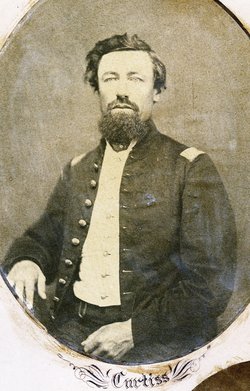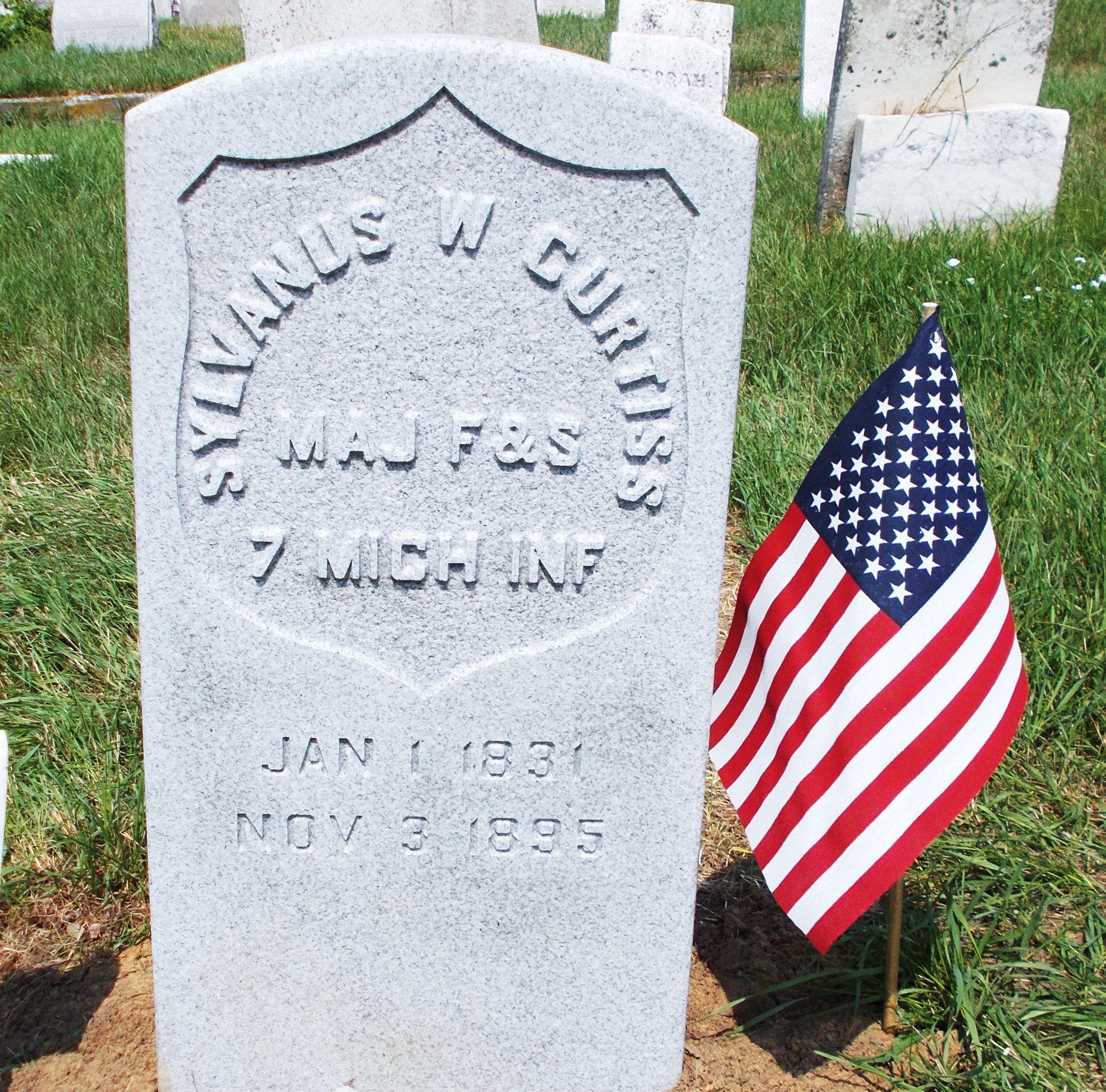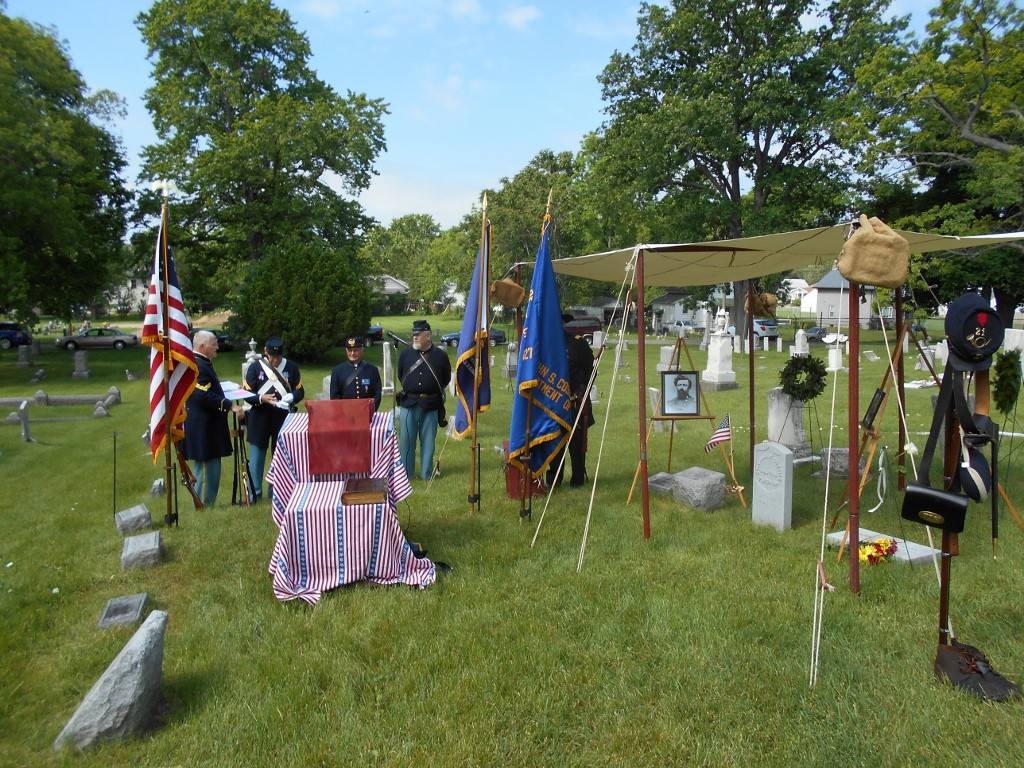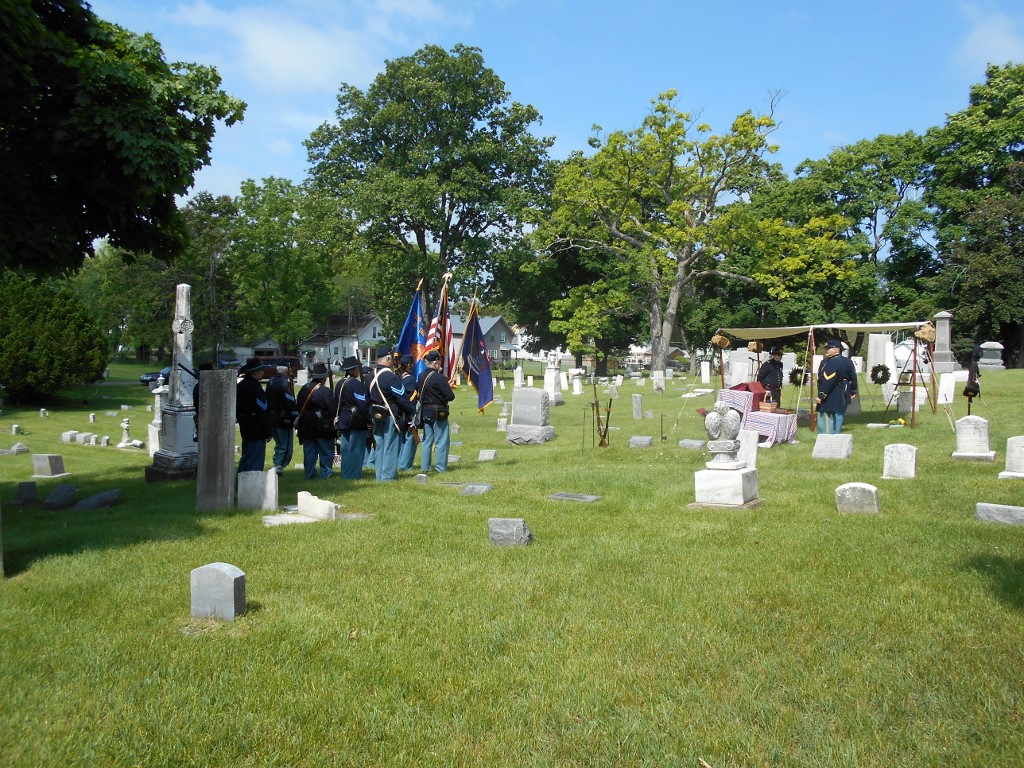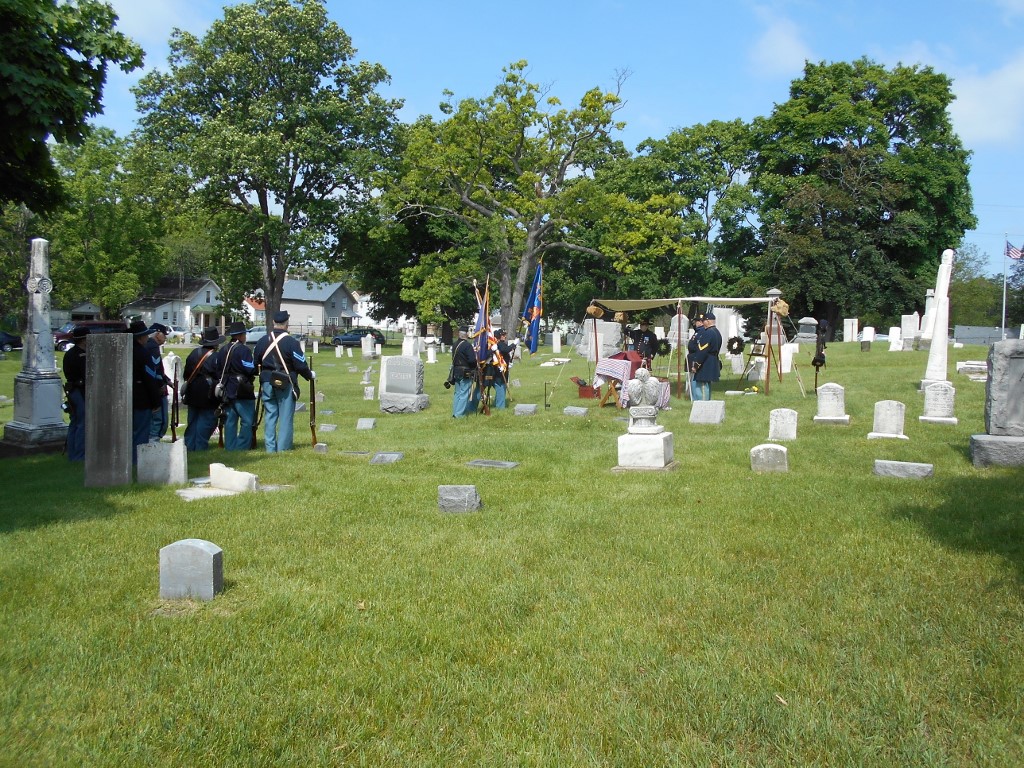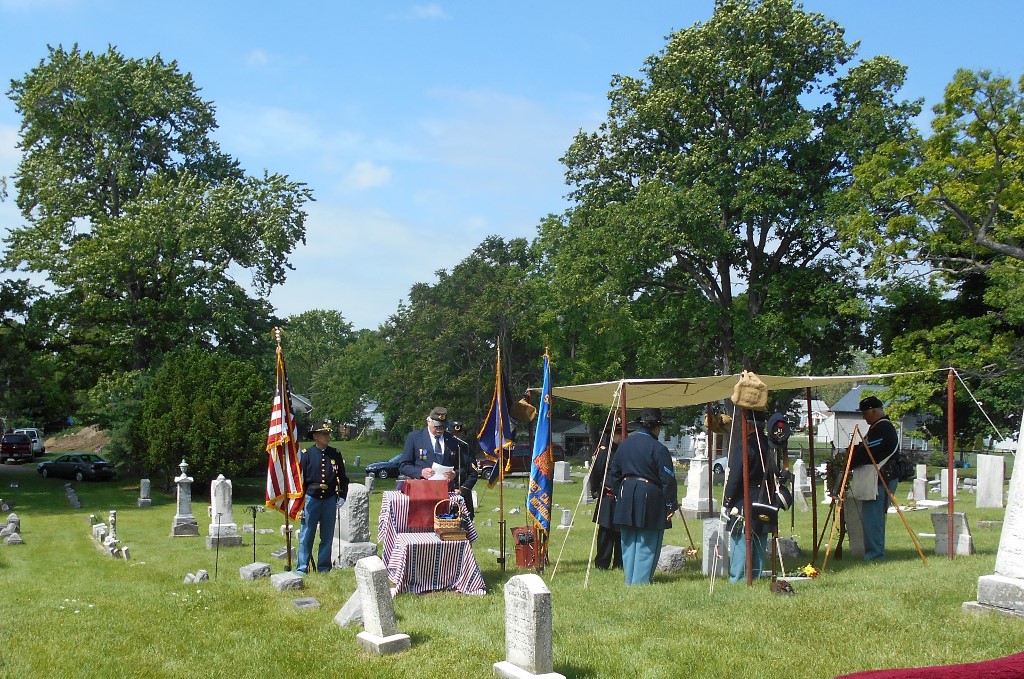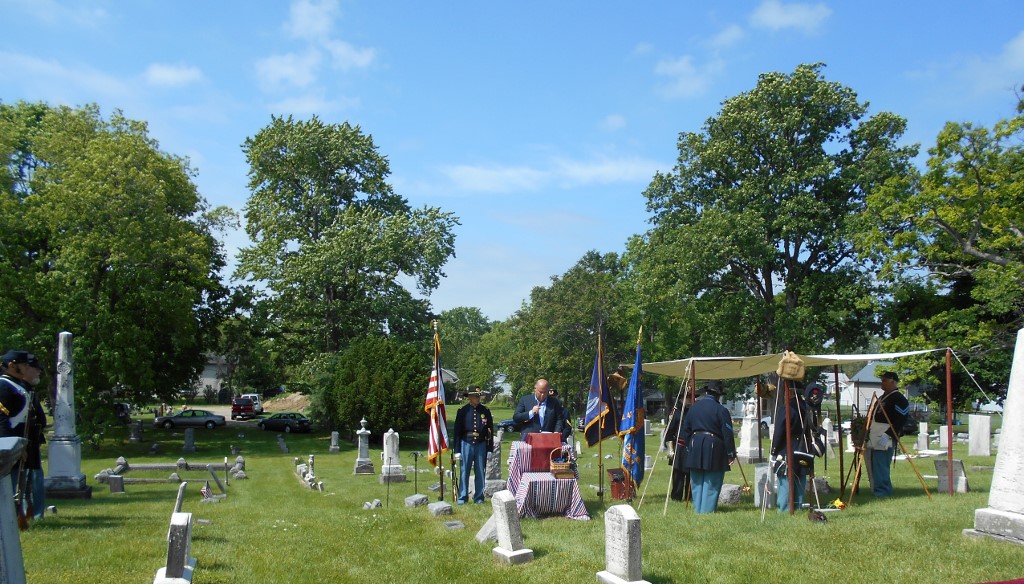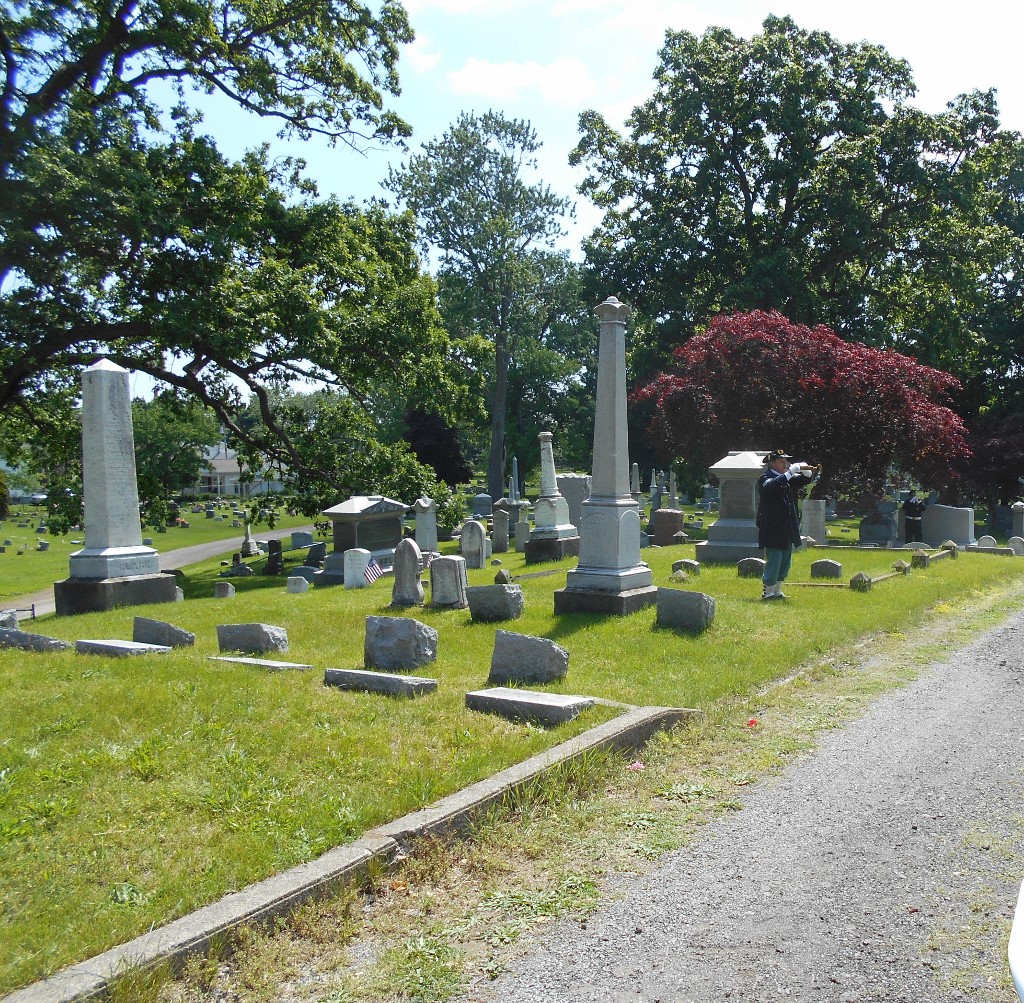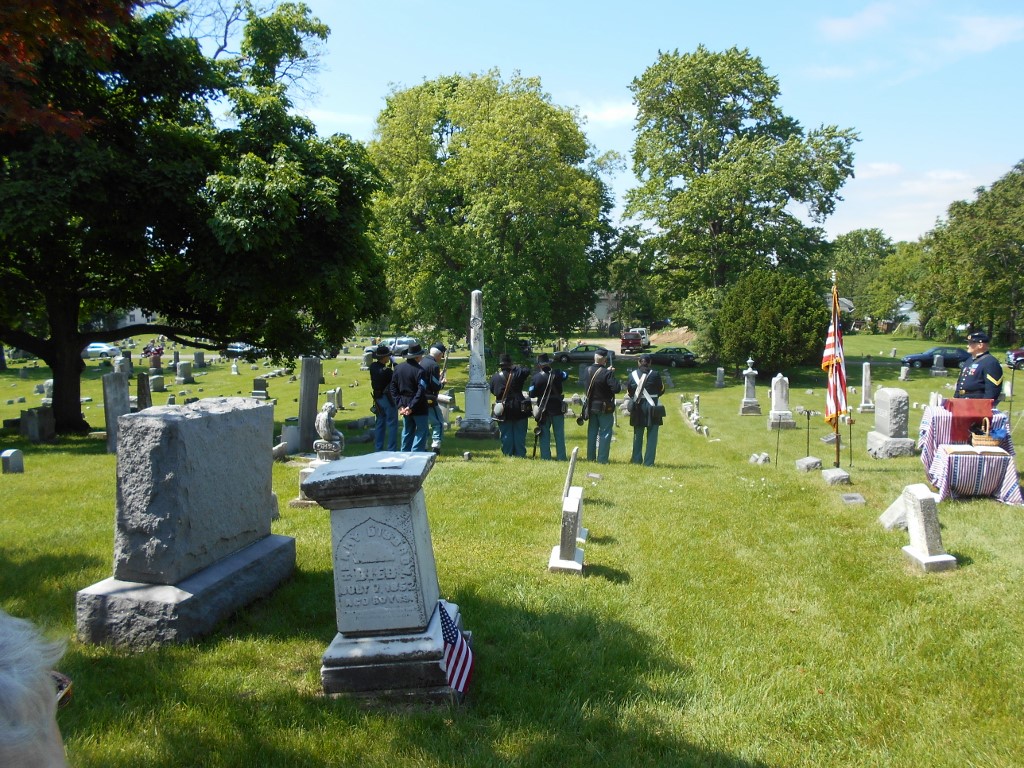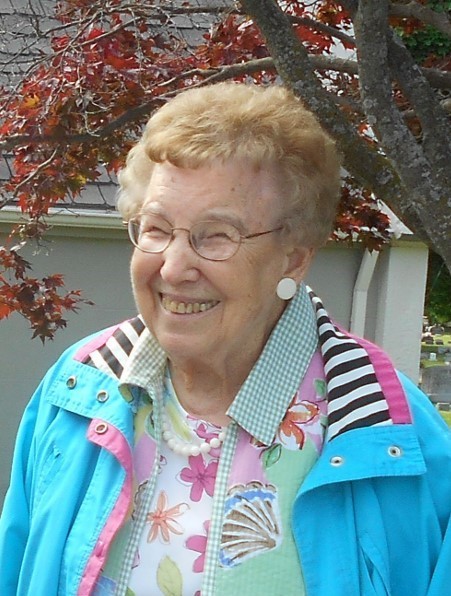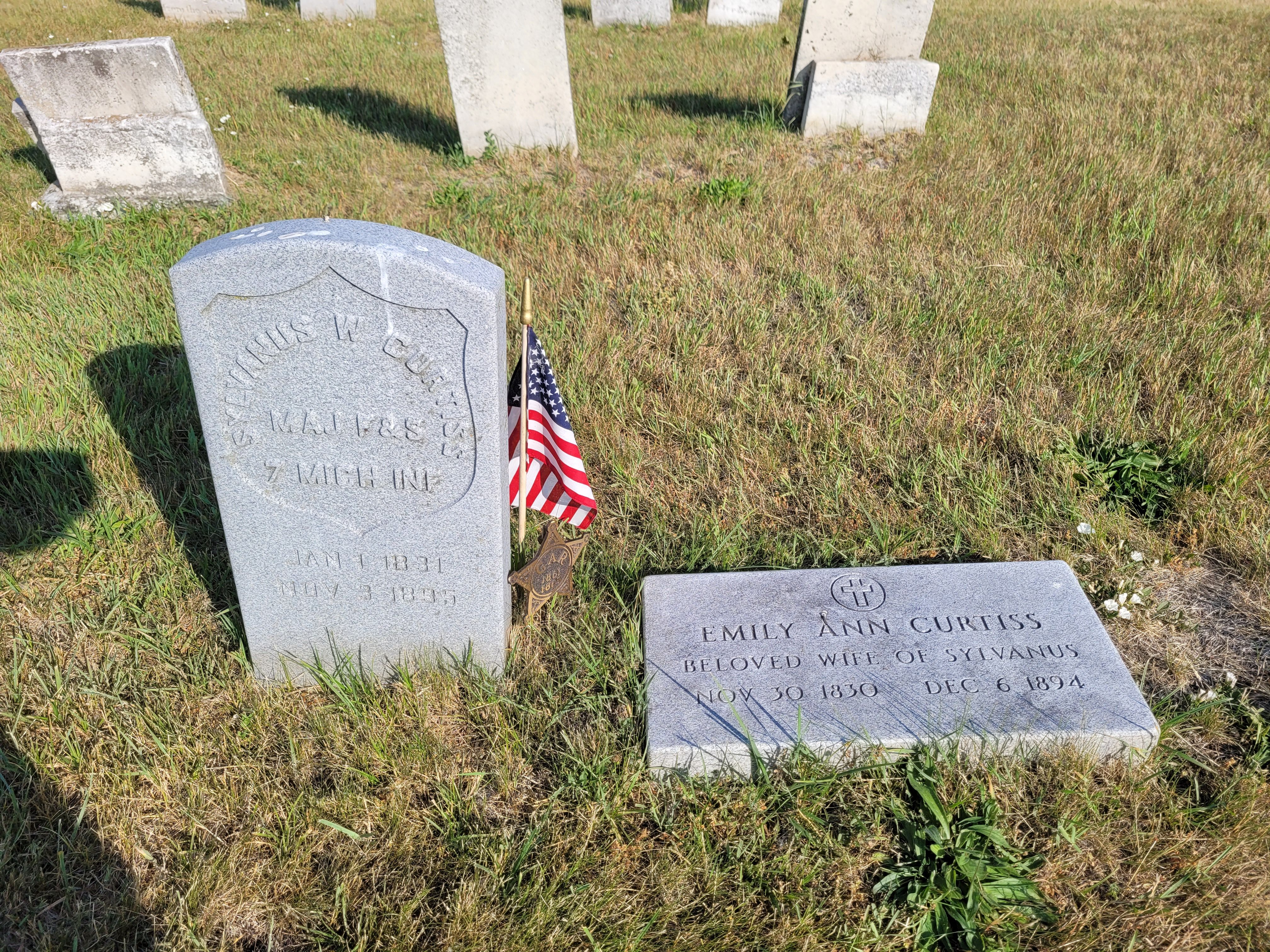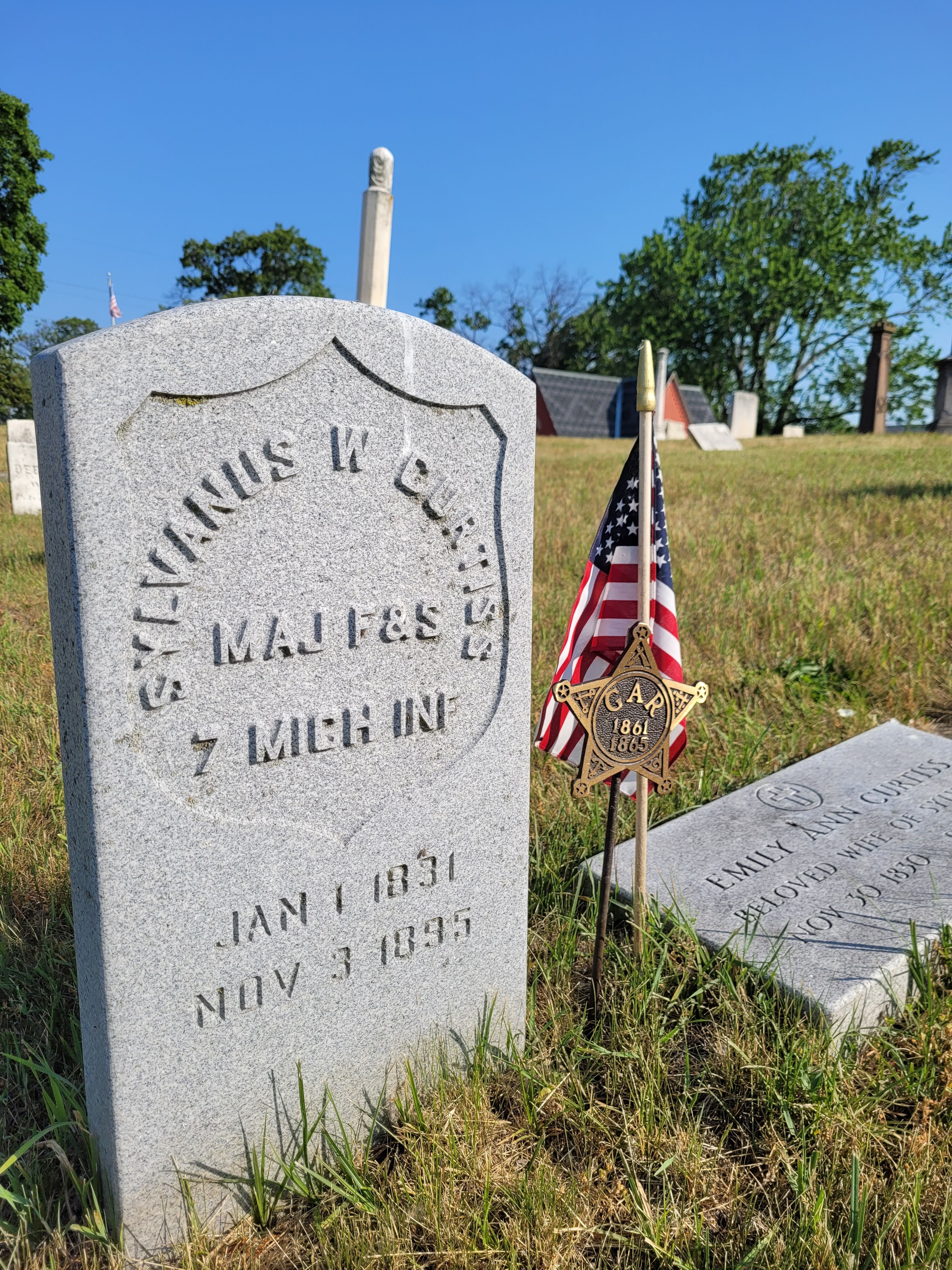MONROE COUNTY, MICHIGAN
CO D 7TH MICHIGAN INFANTRY
*Enlisted as a 1st Lieutenant on June 19, 1861 at the age of 30. Promoted to Full 1st Lieutenant on June 19, 1861. Enlisted in Company D, 7th Infantry Regiment Michigan on August 22, 1861. Promoted to Full Captain on March 1, 1862. Promoted to Full Major on May 26, 1863. Commanded regiment from July 1863 to September 1864. Wounded in action at Spotsylvania, VA. on May 10, 1864. Discharged from Company D, 7th Infantry Regiment Michigan on October 5, 1864. Son of Norman and Mary Hadden Curtiss. Married Emily Ann Howe in Detroit on November 5, 1854. Was a charter member of the Monroe GAR Post. Has a new marker. (GSMC)
Casualty: No
Pension: Yes
Marker: Yes
**Major Sylvanus W. Curtiss, commanded the 7th Michigan Infantry from July, 1863 to Sept. 1864. He was wounded at Spotsylvania, VA. on May 10, 1864. Living in Monroe, Michigan, he was elected to become a member of the Mason Lodge No. 27 on March 23, 1853. Following the acceptance, he was then appointed as Senior Deacon of the lodge on December 14, 1853. After returning home from the war, Sylvanus became active in his community of Monroe, Michigan. From 1874 through 1877, he was elected and served as the school inspector of Monroe. In 1883 and 1884, he was elected and served as the Fourth Ward Supervisor of the city. Slyvanus Curtiss was always dedicated to serving his home community of Monroe County, Michigan. (Lo Marie)
***Maj. Curtiss was also wounded at the battle of Antietam in 1862. He returned to the 7th in time for the valiant river crossings at Fredericksburg in December 1862. At Gettysburg, the 7th went into the line on July 2, under the command of Col. Amos Steele, approximately 150 yards from the infamous "angle" in the stone wall along the Emmitsburg Road. The next day, Maj. Curtiss took command of the 7th when Col. Amos Steele was killed in action during the repulse of Pickett's Charge. Maj. Curtiss remained in command of the 7th until he was wounded in the stomach at Spotslyvania, Va in 1864. At the time of his death, he still bore an open wound from that action.
(#48021596***Gr-Gr-Grandson, E. Mueller)
MAY HE FOREVER BE REMEMBERED
MARKER DEDICATION
A beautiful blue sky shown overhead on a warm Saturday morning, June 6, 2015, as friends, family, interested guests, along with the Sgt. John S. Cosbey Camp 427 Sons of the Union Veterans of the Civil War, and Civil War period dressed re-enactors gathered to give Major Sylvanus W. Curtiss of the 7th Michigan Infantry, a formal "Grand Army of the Republic Burial Service," marker dedication. After 119 years, a headstone marked the burial location of a hero of the War of the Rebellion, where no marker was ever placed. A marker was also placed for his wife Emily at the same time, who is buried next to him. Sylvanus Curtiss, a soldier who had carried an open wound for 31 years, that he had received in action; a citizen who was much loved by his community, a person who was much respected by his friends of Monroe, Mi., and a man who was always remembered by his great-great-grandson and family, was Rightfully Honored as one of America's heroes that fought to save the Nation from 1861-1865.
Click on photos of military marker dedication
Note: This memorial was sent to me by D. Curtis just after he made it, who said, "Find something on him" and find I did. Many thanks to D. Curtis. Many thanks to Eric Mueller and Jane Sommer for providing the necessary info to get a military marker. (Lo Marie #47331076)
A GOOD CITIZEN GONE
A sturdy and well known figure, long familiar to the citizens of Monroe, will pass in and out among us no more. An upright and honorable citizen has passed the borders of the silent sea to the reward awaiting him beyond.
After being in failing health for about a year, a few days since Major Sylvanus W. Curtiss was stricken with apoplexy from which he lingered until Sunday morning November 3rd, when at about nine o'clock, he breathed his last.
Sylvanus W. Curtiss, was born in Genesee County, N.Y., January 1st, 1831. He was the son of Dr. Norman Curtiss. The family removed to Michigan when he was about ten years old and settled in Monroe, living in the old Custer house. At the age of twenty-seven, he was married at Detroit to Emily Howe and removed to the village of Petersburg where he lived for about two years, returning thence to Monroe some four years prior to the beginning of the civil war and has since made this city his home.
(In 1870 and 1880, Sylvanus made his home on West Fourth Street, in the First Ward of the city of Monroe, Michigan. He was employed first as a butcher and then as a clerk. - Lo Marie)
Previous to 1861 he was 1st Lieutenant of the old state military organization known as the "City Guards," which at the outbreak of the war was incorporated into a post of the 7th Michigan Infantry. Lieut. Curtiss went to the front with this regiment in 1861 as Lieut. and served 40 months, during a large portion of which he was in actual command of the regiment, he having early been promoted to Major and Col. Hall being absent on other service. He was with the regiment during some of the fiercest battles of the war-notably the Peninsular campaigns Antietam and Gettysburg. He was seven times wounded and at his death still carried an open wound.
He was a man of uncompromising integrity and held numerous positions of public trust. He was largely instrumental in ferreting out the ditch frauds of a quarter of a century ago; was County Drain Commissioner, Alderman of the Fourth Ward for two terms, Supervisor for three terms, a member of the board of education for 12 years and at his death was serving as County Commissioner of the Poor.
His wife died December 1st, 1891, and of four children three survived him, Walter S., Sylvanus W. Jr., of Detroit, and Mary H. of Monroe. Funeral services on Tuesday afternoon were conducted by the G.A.R. of which he was 1st Post Commander and by the Masonic fraternity, he having been one of the two surviving charter members of Eureka Lodge F. & A. M. (obituary, 1895 MD)
COMMUNITY SERVANT
On July 4, 1872, at an early hour, people flocked into the city of Monroe, Michigan from the country side, by wagon loads, on horseback and on foot, before the arrival of several trains into the city. The occasion for such excitement was the first reunion of the remaining soldiers of the battle of 1812 that happened in the early years of Monroe in Frenchtown. The first train from the north brought the governor, the national guards of Detroit, Baldwin, Campbell, Trowbridge, Bishop, Cooley and other state dignitaries. The train from the west brought the Adrian Commandery of Knights Templar, and the train from the south brought Mayor Jones, Ex-Mayor Kraus of the Toledo Cadets, along with thousands of people that joined in the festivities that were planned for the day of celebration. Major S. W. Curtiss was the Parade Marshal of the Fifth Division and headed the "Pioneers of the Raisin Valley to the number of 150". The parade procession started at First and Macomb, north to Elm Avenue, west to Monroe St, south to Front, Cass to Seventh, then to Washington St. The festivities were exciting, with many dignitaries coming from many states. Sylvanus Curtiss took much pride working with his fellow citizens that planned and executed the huge undertaking of this one of a kind reunion in Monroe, Monroe County, Michigan.
Sylvanus Curtiss was elected by his peers in Monroe, Michigan in the year of 1876, right after the death of Gen.George Custer, who died on the battlefield of the Little Big Horn in Montana to serve on the Executive Committee to erect a monument in Custer's memory in Monroe, Michigan where General Custer had once lived. Sylvanus lived in the old Custer Home on North Custer Road at one time. Many state, federal, and local dignitaries formed the executive committee so that Monroe local residents could have some input on the monument that would be placed. It was named the Custer Memorial Association, not to be confused with the Custer National Monument Association. A beautiful bronze statue was selected, but many years went by before the monument was done and the dedication took place in 1910. Sadly, Sylvanus died before the unveiling took place in Monroe with President Taft of the United States leading the parade.
MONROE COUNTY, MICHIGAN
CO D 7TH MICHIGAN INFANTRY
*Enlisted as a 1st Lieutenant on June 19, 1861 at the age of 30. Promoted to Full 1st Lieutenant on June 19, 1861. Enlisted in Company D, 7th Infantry Regiment Michigan on August 22, 1861. Promoted to Full Captain on March 1, 1862. Promoted to Full Major on May 26, 1863. Commanded regiment from July 1863 to September 1864. Wounded in action at Spotsylvania, VA. on May 10, 1864. Discharged from Company D, 7th Infantry Regiment Michigan on October 5, 1864. Son of Norman and Mary Hadden Curtiss. Married Emily Ann Howe in Detroit on November 5, 1854. Was a charter member of the Monroe GAR Post. Has a new marker. (GSMC)
Casualty: No
Pension: Yes
Marker: Yes
**Major Sylvanus W. Curtiss, commanded the 7th Michigan Infantry from July, 1863 to Sept. 1864. He was wounded at Spotsylvania, VA. on May 10, 1864. Living in Monroe, Michigan, he was elected to become a member of the Mason Lodge No. 27 on March 23, 1853. Following the acceptance, he was then appointed as Senior Deacon of the lodge on December 14, 1853. After returning home from the war, Sylvanus became active in his community of Monroe, Michigan. From 1874 through 1877, he was elected and served as the school inspector of Monroe. In 1883 and 1884, he was elected and served as the Fourth Ward Supervisor of the city. Slyvanus Curtiss was always dedicated to serving his home community of Monroe County, Michigan. (Lo Marie)
***Maj. Curtiss was also wounded at the battle of Antietam in 1862. He returned to the 7th in time for the valiant river crossings at Fredericksburg in December 1862. At Gettysburg, the 7th went into the line on July 2, under the command of Col. Amos Steele, approximately 150 yards from the infamous "angle" in the stone wall along the Emmitsburg Road. The next day, Maj. Curtiss took command of the 7th when Col. Amos Steele was killed in action during the repulse of Pickett's Charge. Maj. Curtiss remained in command of the 7th until he was wounded in the stomach at Spotslyvania, Va in 1864. At the time of his death, he still bore an open wound from that action.
(#48021596***Gr-Gr-Grandson, E. Mueller)
MAY HE FOREVER BE REMEMBERED
MARKER DEDICATION
A beautiful blue sky shown overhead on a warm Saturday morning, June 6, 2015, as friends, family, interested guests, along with the Sgt. John S. Cosbey Camp 427 Sons of the Union Veterans of the Civil War, and Civil War period dressed re-enactors gathered to give Major Sylvanus W. Curtiss of the 7th Michigan Infantry, a formal "Grand Army of the Republic Burial Service," marker dedication. After 119 years, a headstone marked the burial location of a hero of the War of the Rebellion, where no marker was ever placed. A marker was also placed for his wife Emily at the same time, who is buried next to him. Sylvanus Curtiss, a soldier who had carried an open wound for 31 years, that he had received in action; a citizen who was much loved by his community, a person who was much respected by his friends of Monroe, Mi., and a man who was always remembered by his great-great-grandson and family, was Rightfully Honored as one of America's heroes that fought to save the Nation from 1861-1865.
Click on photos of military marker dedication
Note: This memorial was sent to me by D. Curtis just after he made it, who said, "Find something on him" and find I did. Many thanks to D. Curtis. Many thanks to Eric Mueller and Jane Sommer for providing the necessary info to get a military marker. (Lo Marie #47331076)
A GOOD CITIZEN GONE
A sturdy and well known figure, long familiar to the citizens of Monroe, will pass in and out among us no more. An upright and honorable citizen has passed the borders of the silent sea to the reward awaiting him beyond.
After being in failing health for about a year, a few days since Major Sylvanus W. Curtiss was stricken with apoplexy from which he lingered until Sunday morning November 3rd, when at about nine o'clock, he breathed his last.
Sylvanus W. Curtiss, was born in Genesee County, N.Y., January 1st, 1831. He was the son of Dr. Norman Curtiss. The family removed to Michigan when he was about ten years old and settled in Monroe, living in the old Custer house. At the age of twenty-seven, he was married at Detroit to Emily Howe and removed to the village of Petersburg where he lived for about two years, returning thence to Monroe some four years prior to the beginning of the civil war and has since made this city his home.
(In 1870 and 1880, Sylvanus made his home on West Fourth Street, in the First Ward of the city of Monroe, Michigan. He was employed first as a butcher and then as a clerk. - Lo Marie)
Previous to 1861 he was 1st Lieutenant of the old state military organization known as the "City Guards," which at the outbreak of the war was incorporated into a post of the 7th Michigan Infantry. Lieut. Curtiss went to the front with this regiment in 1861 as Lieut. and served 40 months, during a large portion of which he was in actual command of the regiment, he having early been promoted to Major and Col. Hall being absent on other service. He was with the regiment during some of the fiercest battles of the war-notably the Peninsular campaigns Antietam and Gettysburg. He was seven times wounded and at his death still carried an open wound.
He was a man of uncompromising integrity and held numerous positions of public trust. He was largely instrumental in ferreting out the ditch frauds of a quarter of a century ago; was County Drain Commissioner, Alderman of the Fourth Ward for two terms, Supervisor for three terms, a member of the board of education for 12 years and at his death was serving as County Commissioner of the Poor.
His wife died December 1st, 1891, and of four children three survived him, Walter S., Sylvanus W. Jr., of Detroit, and Mary H. of Monroe. Funeral services on Tuesday afternoon were conducted by the G.A.R. of which he was 1st Post Commander and by the Masonic fraternity, he having been one of the two surviving charter members of Eureka Lodge F. & A. M. (obituary, 1895 MD)
COMMUNITY SERVANT
On July 4, 1872, at an early hour, people flocked into the city of Monroe, Michigan from the country side, by wagon loads, on horseback and on foot, before the arrival of several trains into the city. The occasion for such excitement was the first reunion of the remaining soldiers of the battle of 1812 that happened in the early years of Monroe in Frenchtown. The first train from the north brought the governor, the national guards of Detroit, Baldwin, Campbell, Trowbridge, Bishop, Cooley and other state dignitaries. The train from the west brought the Adrian Commandery of Knights Templar, and the train from the south brought Mayor Jones, Ex-Mayor Kraus of the Toledo Cadets, along with thousands of people that joined in the festivities that were planned for the day of celebration. Major S. W. Curtiss was the Parade Marshal of the Fifth Division and headed the "Pioneers of the Raisin Valley to the number of 150". The parade procession started at First and Macomb, north to Elm Avenue, west to Monroe St, south to Front, Cass to Seventh, then to Washington St. The festivities were exciting, with many dignitaries coming from many states. Sylvanus Curtiss took much pride working with his fellow citizens that planned and executed the huge undertaking of this one of a kind reunion in Monroe, Monroe County, Michigan.
Sylvanus Curtiss was elected by his peers in Monroe, Michigan in the year of 1876, right after the death of Gen.George Custer, who died on the battlefield of the Little Big Horn in Montana to serve on the Executive Committee to erect a monument in Custer's memory in Monroe, Michigan where General Custer had once lived. Sylvanus lived in the old Custer Home on North Custer Road at one time. Many state, federal, and local dignitaries formed the executive committee so that Monroe local residents could have some input on the monument that would be placed. It was named the Custer Memorial Association, not to be confused with the Custer National Monument Association. A beautiful bronze statue was selected, but many years went by before the monument was done and the dedication took place in 1910. Sadly, Sylvanus died before the unveiling took place in Monroe with President Taft of the United States leading the parade.
Inscription
MAJ F & S
7 MICH INF
Gravesite Details
There was no grave marker until Aug. 9, 2014
